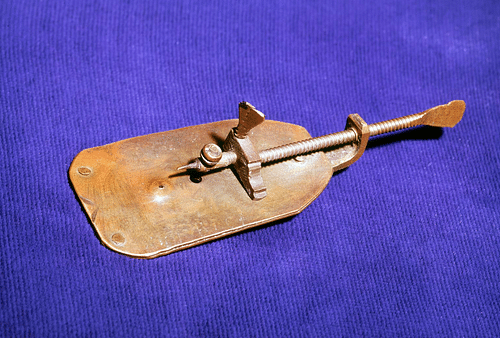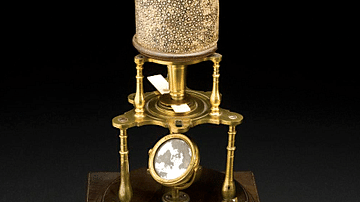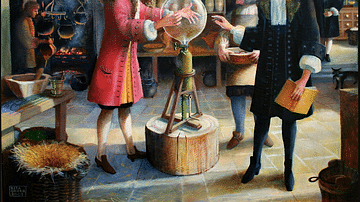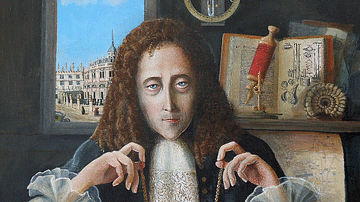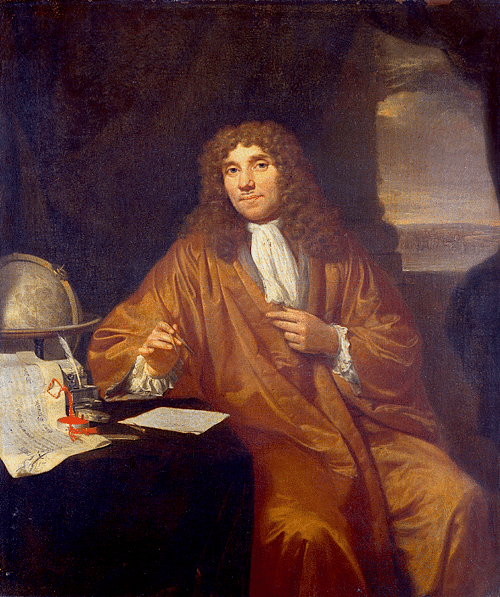
Antonie van Leeuwenhoek (1632-1723) was the most important microscopist of the Scientific Revolution. The Dutchman made over 500 microscopes, many with a magnification far superior to contemporary models. His discoveries include bacteria, protozoa, red blood cells, spermatozoa, and how minute insects and parasites reproduce.
Early Life
Unusually for one of the most prominent scientists of the 17th century, Antonie van Leeuwenhoek did not belong to the upper classes. He was born in Delft in the Netherlands into a low middle-class family on 24 October 1632. Antonie's family were brewers, and he did not have the opportunity to study at university or learn Latin or French, the two principal languages of scientific communication at the time. These handicaps were serious, especially regarding finance since most scientists had independent means to fund their often expensive research. Leeuwenhoek was obliged to fund his research into microscopy by working both as a draper (he had trained in this profession in Amsterdam) and as a minor municipal officer in Delft. Significantly, perhaps, for his future achievements, in his work inspecting cloth, he used magnifying glasses.
Leeuwenhoek's Microscopes
In the second decade of the 17th century, the microscope quickly followed the telescope as one of the most important instruments of the Scientific Revolution. A whole new miniature world was opened up to scientists. Anatomists, entomologists, and botanists were particularly keen to use this new invention to further their understanding of the natural world. Life under the microscope suddenly became unimaginably more intricate and complex.
Leeuwenhoek seems to have first made microscopes in the early 1670s. He may have become interested in the subject following the raging success of Micrographia, a richly illustrated book by Robert Hooke (1635-1703) on the wonders that could be observed on a microscopic slide. Certainly, Leeuwenhoek's investigations seem to follow the order of Hooke's book, suggesting he had his own copy.
A microscope made by Leeuwenhoek is mentioned in a 1673 letter between two noted scientists, Reinier de Graaf and Henry Oldenburg. Leeuwenhoek made over 500 microscopes in his career, grinding his own glass lenses. He invented a small and beautifully simple microscope that used, instead of the usual glass lens, a tiny glass bead fixed in position between two metal plates. Leeuwenhoek's bead microscope was capable of a highly impressive magnification of 270 times. Leeuwenhoek added a scale of measurement to his mini-microscope, and this allowed a more accurate comparison of views and specimens. In an age where sharing scientific data became paramount, he also devised a way for other microscopists to compare scale by using a base measurement such as the thickness of a strand of human hair or a grain of sand. In this way, microscopists elsewhere could better understand each other's work.
Leeuwenhoek's Discoveries
Far from being a mere technician, Leeuwenhoek put his microscopes to good use and made several important discoveries in this still-new field of inquiry. His "contributions include the discovery of red blood cells, of the circulation of blood through the capillaries, of the existence of protozoa, and of the nature of the male sperm cells" (Burns, 166). He also discovered bacteria, what he called "animalcules", seen in such things as samples taken from animal intestines. Another discovery was that minute insects, invisible to the naked eye, reproduced just like larger lifeforms and not through some sort of spontaneous reaction as was then widely supposed.
Leeuwenhoek was particular since he was interested in viewing just about anything in his microscopes, as here summarised by the historian W. E. Burns:
He asked his neighbours for items to examine, like hair clippings or blood samples; he obtained from local businesses items such as infested grain and pieces of butchered animals; and he went to the dock to sample the wide range of goods available there, such as whale skins. Nor was Leeuwenhoek averse to putting portions of his own body under the lens, publishing the results of microscopic examination of tartar from his teeth in 1683…and detailing the analysis of a substance found between Leeuwenhoek's toes after he had left his stockings on for two weeks.
(166)
In just one example of Leeuwenhoek's unquenchable curiosity and willingness to use the people around him, he investigated what it was that caused the common ailment of gout. He knew a sufferer with the unfortunate symptom of a chalk-like substance excreted from two holes in his joints, one from the heel and the other from an elbow. Leeuwenhoek summarised what happened next in a letter:
I asked him to let me have some of the chalk which he willingly granted me…I observed the solid matter which to our eye resembles chalk, and I saw to my great astonishment that I was mistaken in my opinion, for it consisted of nothing but long, transparent little particles, many pointed at both ends.
(Jardine, 299)
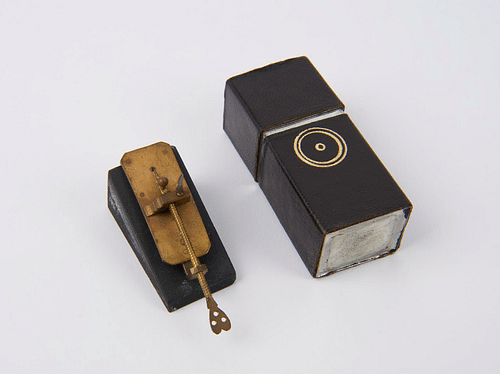
These particles which Leeuwenhoek observed, we now know, are deposits of sodium urate caused by an excess of uric acid in the blood.
In another letter, Leeuwenhoek gives the following description of how he discovered protozoa, as it happens, entirely by accident since the Dutchman was really trying to "discover the cause of the pungency of pepper upon our tongue" (Jardine, 94):
I put about one third of an ounce of whole pepper in water, placing it in my study, with the sole design thereby that the pepper being rendered soft I might be enabled the better to observe what I proposed to myself. This pepper having lain three weeks in the water, to which I had twice added some snow water [the purest water available] (the other water being exhaled) I looked upon it the 24th of April, 1676, and discerned to my great wonder, an incredible number of very small animals of divers kinds.
(Jardine, 92)
Leeuwenhoek's Theory of Life
Leeuwenhoek's discovery of spermatozoa around 1677 led him to formulate a theory of the reproduction cycle. Scientists were still divided over exactly how new life was created, most pertinently in humans. Traditionally, the male was considered more important in reproduction, a view held by males to bolster their own ideas that they should be more important. However, by the 17th century, it had become clear that most new life came from a female-produced egg of one sort or another, and so the prevailing theory was 'ovism', that is, the essential characteristics of the new life form were all present in an egg which awaited fertilisation. Leeuwenhoek proposed the opposite since he believed the spermatozoa and not the egg contained such characteristics as the life form's soul. He "developed a preformationist theory in which new creatures are elaborated in the male's semen (governed by the father's animal soul) before conception and subsequently grow in the mother's womb with the nutriment provided by the egg" (Henry, 83).
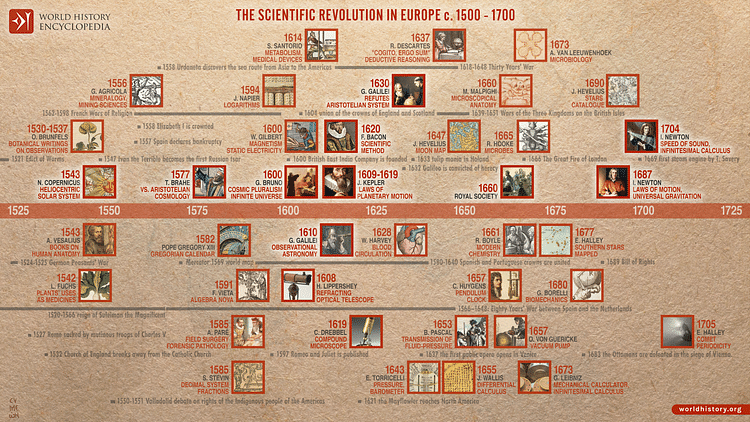
Leeuwenhoek's theory was not widely accepted, and he even got into trouble for discussing such intimate matters in public (some also wondered where and how he had got his specimens from). Nevertheless, Leeuwenhoek's discovery of spermatozoa and other previously unknowns was an example of how in the Scientific Revolution such discoveries were flames used to test and purify existing explanatory theories or destroy them or forge entirely new ones.
International Recognition
Leeuwenhoek was aware that to make his discoveries more widely known and useful to the scientific community he needed to capture them in drawings. Leeuwenhoek employed local draughtsmen to create precise images of what he had seen in his microscopes. He sent almost all of his research findings, including the specially commissioned illustrations, to the Royal Society in London. The historian L. Jardine explains the microscopist's approach:
He made no pretence to expertise in anything apart from the manipulation of his microscopes; he presented his observations as raw data, in day-by-day diary form, ‘that they might be better credited in England and elsewhere'. 'I beg you and the Gentlemen under whose eyes this happens to come to bear in mind that my observations and opinions are only the result of my own impulse and curiosity,' he explained, with studied humility.
(90)
Hundreds of these papers were then translated from the Dutch originals and published in the society's unofficial magazine Philosophical Transactions between 1673 and 1723. Many of Leeuwenhoek's letters to the society were subsequently published in collected volumes, too. In 1680, Leeuwenhoek was invited to become a fellow of the society. Leeuwenhoek was also a long-time contributor to the Dutch journal De Boekzaal van Europe.
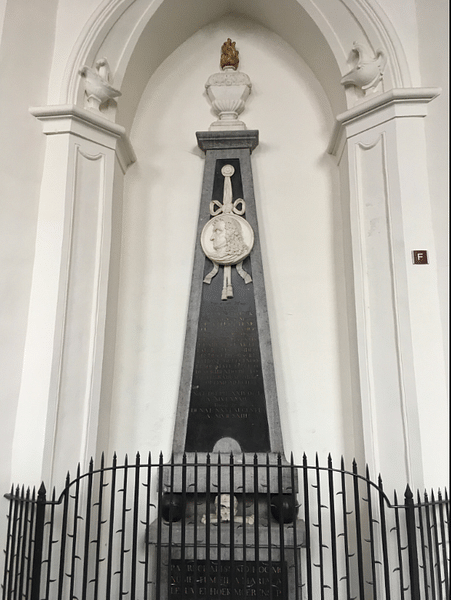
Leeuwenhoek became so accomplished at preparing and observing specimens on microscopic slides that he was far ahead of most of his fellow scientists in what he made possible to see viewed under high magnification. Indeed, so high was the magnification and clarity that no other microscopists could replicate what he saw, and so some doubted that Leeuwenhoek had ever seen such things. There was certainly some mystery involved because Leeuwenhoek refused to reveal just how he lit up his specimens, a necessity to be able to see anything clearly under high magnification. Eventually, other scientists like Hooke caught up and proved that Leeuwenheok was indeed seeing things never before seen.
The Dutchman's work became so well known that he was able to offer his house in Delft as a sort of open museum where the public could visit and see prepared slides in the many microscopes he had set up. Monarchs visited, including James II of England (r. 1685-1688) and Peter the Great of Russia (1682-1721), as did eminent scientists such as Christiaan Huygens (1629-1695), the inventor of the pendulum clock.
Antonie van Leeuwenhoek died in Delft on 26 August 1723 at the ripe old age of 90. He had outlived two wives and had only one child. He had shown the way for other scientists to follow and had created a specialization in new fields of inquiry such as protozoology and bacteriology. The microscope, always difficult to use even in accomplished hands, fell out of favour in the 18th century but returned in the next century, particularly in the field of medicine, when the technical deficiencies of lenses, lights, and slide preparation were greatly improved. Leeuwenhoek did much, then, to ensure this instrument became a vital tool in modern science.
